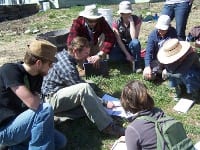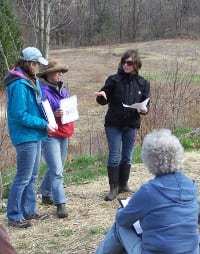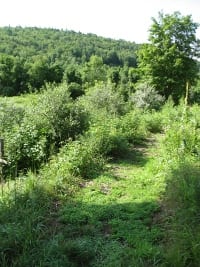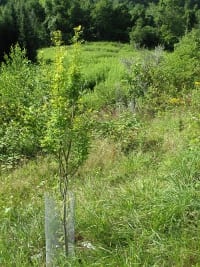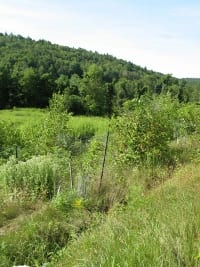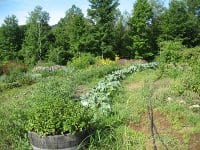by Mollie Babize
On a south-facing hillside in Conway, Massachusetts, an eight-acre experimental landscape and permaculture classroom is evolving. In its third year, this outdoor “learning lab” sits in close proximity to the Conway School, a ten-month graduate program in sustainable landscape planning and design. Jono Neiger, principal of Regenerative Design Group of Greenfield and the primary designer/“editor” of this landscape, also teaches at Conway and uses this property to illustrate the principles of regenerative design to his students.
It’s a remarkably diverse landscape, with six or seven distinct microclimates. When Neiger first arrived on site, the small (1050 square foot) home had already been built near the crest of the property. Excavation of the drive and extensive clearing had left a steep, dry and eroding hillside. At the toe of the slope, a cool wet meadow contrasted with overgrown fir trees from a former Christmas tree plantation. A mature, mixed second-growth woodland surrounded the site.
Design for Sustainability
The owner, recently retired and relocated from Boston, had attended an ELA-sponsored conference where Neiger and Dave Jacke, both Conway graduates, presented a workshop on sustainable site design. She invited Neiger to create a plan for her eight acres that could provide much of her food, would incorporate the principles of a forest garden, and would heal the damaged site.
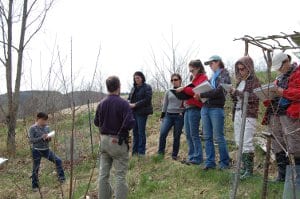
Standing on the steep slope newly planted as a forest garden, Jono Neiger explains to Conway students the principles behind the design.
Neiger’s initial actions were two-fold: stabilize the steeper slopes, and stop mowing to see what emerged. With an “ecological design team,” he selectively removed saplings from the embankment, planted a mix of fruiting shrubs and trees, dug gentle swales on contour to capture and infiltrate water, and used mulch, woody debris and ground covers to further stabilize the slope. Plants were selected to attract beneficial insects, draw up nutrients from deeper soil layers, hold moisture, and restore soil fertility. By mimicking the function of the multiple layers of a forest, this type of planting plan requires little in the way of maintenance and inputs such as fertilizers, while providing diverse yields – for humans and other site residents – once established.
“It was tricky because it was so steep,” says Neiger. “We did a lot of hand clearing and scything, the kind of selective clearing you cannot do with a lawn mower.”
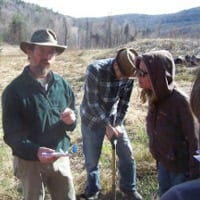
Jono Neiger integrates his restorative projects with on-site education for students at the Conway School.
Working with Nature
Although some of the species emerging are identified exotic invaders – like the Autumn Olive (Elaeagnus umbellata) – Neiger chose to work with them. “These species are disturbance-adapted,” he explains. “So rather than disturb more and encourage their spread, we try to speed up succession, to move it further along.” The main principle, he says, is not to fight nature. Autumn Olive helps to stabilize the soil and fixes nitrogen, he explains, and has delicious berries that have a great deal of anti-oxidant value. “We don’t want to be at war with the land!” he exclaims. It is a controversial position at odds with some proponents of native plant communities, since the same tree can out-compete native species.
“We are living in a time of rapidly changing climate – air temperatures, soil qualities, species, entire ecosystems are changing. We really don’t understand the consequences or extent of change at this point. The best we can do is to build resilient ecosystems, and design for change.” As an example, Neiger points to the City of Chicago, where trees are being replaced with a mix of more southern species, anticipating a warmer climate.
Experiment and Observe
A large part of the process of resilient design, says Neiger, is observation. “We are consciously exploring, experimenting, and moving forward very carefully. We are trying out different species, a different mix of species, and different systems.”
This property, in close proximity to the Conway School’s 34 wooded acres, provides an opportunity to involve Conway’s graduate students in this experiment. Neiger has students set up test plots, experiment with different crops such as rice, and monitor the site. There are two green roofs – the one on the house is maturing at three years, and a new one was just established on a greenhouse. There are work projects in the forest garden, adding more plants, setting up polycultures. “Students can balance what they are studying with active field work. It provides an opportunity to see a property evolve over time.”
Neiger wants to do more with water systems as well. “These disturbed soils aren’t as deep; the capacity of land to hold water and release it slowly is reduced. We need to rebuild the soil, the vitality of the ecosystem, and then create systems that are more conscious of managing water on the land.”
Land as Classroom
Since each Conway class is only in residence for ten months, subsequent classes will continue to document the changes over time, and compare it with previous student work. Neiger also sees good potential for hosting a workshop on this property for ELA members as well. “There is a lot of opportunity here,” he says.
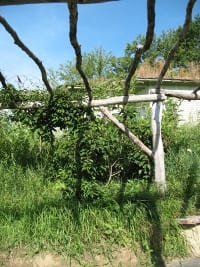
A controversial hardy kiwi is climbing the pergola; Neiger says this is a valuable source of vitamin C that can survive cold climates.
Clearly, the kind of work Neiger does is more about stewardship than design. “We don’t just produce a plan and leave it there,” he says. “We engage the homeowner in the care, maintenance, and monitoring of the plan. We work with them over a period of years to help put these systems in place.” It is what he calls a “mentored design process.”
Design by Editing
It is also design by editing: through careful observation of what is there, what the conditions are, and selective removal he encourages a healing process for the land. As he observes the site over time, he adjusts the plan as necessary. His philosophy is about giving back: “The land nurtures us in so many ways. It feeds us, provides medicines, is beautiful. We need to regenerate the soil, rebuild the land, enrich the habitat. Our relationship with the land needs to be reciprocal.”
For Neiger, combining this field work with his teaching provides a good balance. And he sees similar advantage in the Conway program, where students balance class time with field work and real projects in design at all scales. “Students come out of the program not just with a studio portfolio and book knowledge, but a real understanding of ecological design: how water systems work, what soils mean, and how to implement a project over time.” Paraphrasing Oberlin College President David Orr’s statement that a generalist is a specialist of the whole, Neiger says “A strong component of Conway’s program is broadening their knowledge base, learning all aspects of the landscape.”
About the Author
Mollie Babize writes from her home in Ashfield when she isn’t recruiting students for the Conway School’s ten-month graduate program in sustainable landscape planning and design.
The Conway School structures its accredited Master of Arts program around real projects ranging in scale from residences to regions, for which the student is project manager. Each year, 18 or 19 graduate students from diverse backgrounds are immersed in a range of applied landscape studies. The interdisciplinary curriculum is intensive, collaborative, and innovative, bringing a whole systems perspective to real world challenges. Graduates go on to play significant professional roles in various aspects of landscape planning and design, with an eye to conservation and restoration. Make a difference by design; find out more at www.csld.edu or contact Mollie at babize@csld.edu.

